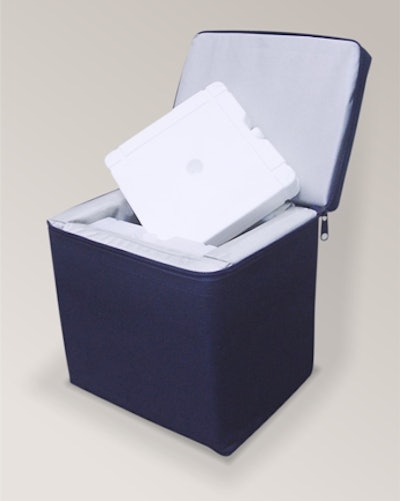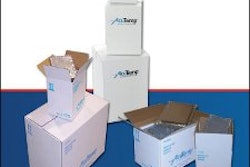
Between 2010 and 2016, the projected growth of biologics is estimated at $62B , up from $130B to $192B. It is predicted that by 2016, eight of the top 10 and 27 of the top 50 best-selling global drug products will require 2 to 8°C cold chain storage and handling .
Temperature excursions are responsible for the degradation of up to 35 percent of the world's vaccines. If the same statistics are applied to temperature-sensitive medications that are being distributed to patients, it could lead to issues around patient safety, poor efficacy leading to maligned results, delays in trials, poor recruitment due to lack of product, and increased costs associated with new batch production.
Understanding the thermal and time challenges temperature-sensitive medications will experience are critical to making an informed decision as to how to protect them against degradation. The expected thermal exposure that the temperature sensitive medication will experience defines the capabilities needed by the temperature control system to provide the necessary level of protection.
Designing the packaging solution
Packaging for temperature-sensitive medications will consist of three items: primary packaging (e.g. vial), secondary packaging (vial box) and tertiary packaging, which provides thermal, physical, and security protection. It is important to remember space/volume costs money to transport, therefore the most efficient secondary packaging possible is preferable as this will ultimately reduce both the size and the weight of the tertiary packaging. Increased density of the payload increases thermal performance and stability of the system.
The key questions to ask include: What is the payload? What is the size of the payload? What temperature does the payload need to maintain? Where is the shipment going in the world? What is the external profile of the transportation route? How long will the shipment take to reach its destination?
Qualification and validation
Once you have the temperature data, the routes and the number of different systems you require, it is time to start the design, qualification, and validation process for the packaging that will ultimately transport temperature-sensitive medication.
There are three clear steps of qualification prior to validation - design qualification (DQ), performance qualification (PQ) and operational qualification (OQ).
Regulatory considerations
The need to maintain the correct temperature is outlined in the good manufacturing practice guides and the good distribution practice guides. The USP 1079 (United States Pharmacopeia) outlines the requirement for storage and distribution of temperature-sensitive healthcare products to be stored and distributed in accordance with these sensitivities. Equivalent guidance is present in many other national regulatory bodies including Health Canada and the European Medicines Agency. Internationally, the WHO has released guidelines for temperature-sensitive healthcare products and vaccines. The International Air Transport Association has published the perishable cargo regulations, which detail the requirements to have clearly identified temperature handling requirements and end-to-end quality agreements for handling these valuable and sensitive healthcare materials.
Working down to national and even state-by-state regulators, the number of regulations and amount of guidance increase. The qualification of a packaging solution to the right specification provides confidence that these regulatory needs are being met and temperature monitoring of shipments can show these needs are being met. With the correct specification defined, the design, performance and operation qualifications completed, and a monitoring system in place, the temperature restrictions upon the product ensure its integrity is maintained.
As you go through the packaging development process, it is important to remember the four S's of packaging design: simple to prepare, simple to pack, simple to label/mark, and simple to ship.
Following these rules will help ensure compliance in the cold supply chain. It is important to remember that there is no such thing as a zero risk shipment. Regardless of how much insulation, phase-change material, and monitoring you place around a payload, there is still a risk associated with shipping since it is unlikely you can truly control the shipment every second of the way. Increased protection will also likely drive up size and use of exotic materials, and in turn increase cost.
The selection of proper packaging design is not simple, the path is well trodden, and the benefits of doing it well may make the difference between a successful trial or failure. The sooner the process of identifying the solution is started, the sooner you will be able to identify the risks and challenges to the distribution of your temperature-sensitive medication. By selecting the right temperature control solution provider you can reduce: risk exposure, loss of valuable product, transportation costs, courier white glove costs, and integrator courier costs. Most importantly, you will be ensuring the temperature-sensitive medication your patient is taking is at its optimal efficacy with no additional risk to patient safety caused by temperature excursions. The patient always comes first.
1World Preview 2016; June 2011; Evaluate Pharma Table 13
²Biopharma Cold Chain 2011 Sourcebook page 13, Table 1
³"Freezing temperatures in the vaccine cold chain: A systematic literature review." By Dipika M. Matthias, Joanie Robertson, Michelle M. Garrison, Sophie Newland and Carib Nelson, 2007.
References:
USP 1079:
WHO: WHO Technical Report Series, No.961, 2011 Annex 9
IATA: iata.org The Perishable Cargo Regulations Manual: THE standard for cargo handling, Chapter 17
Health Canada: Guidelines for Temp. Control Drug Prod. during Storage and Transportation (GUI-0069) / April 28, 2011 EMEA: ec.europa.eu - EU Guidelines on Good Distribution Practice (GDP) of Medicinal Products for Human Use.
Article supplied by Andrew J. Mills, CEO-Americas, and Dr. Alex Roskoss, Ph.D., global head of technical services, Intelsius, a maker of temperature-controlled packaging and cold chain products.
Temperature excursions are responsible for the degradation of up to 35 percent of the world's vaccines. If the same statistics are applied to temperature-sensitive medications that are being distributed to patients, it could lead to issues around patient safety, poor efficacy leading to maligned results, delays in trials, poor recruitment due to lack of product, and increased costs associated with new batch production.
Understanding the thermal and time challenges temperature-sensitive medications will experience are critical to making an informed decision as to how to protect them against degradation. The expected thermal exposure that the temperature sensitive medication will experience defines the capabilities needed by the temperature control system to provide the necessary level of protection.
Designing the packaging solution
Packaging for temperature-sensitive medications will consist of three items: primary packaging (e.g. vial), secondary packaging (vial box) and tertiary packaging, which provides thermal, physical, and security protection. It is important to remember space/volume costs money to transport, therefore the most efficient secondary packaging possible is preferable as this will ultimately reduce both the size and the weight of the tertiary packaging. Increased density of the payload increases thermal performance and stability of the system.
The key questions to ask include: What is the payload? What is the size of the payload? What temperature does the payload need to maintain? Where is the shipment going in the world? What is the external profile of the transportation route? How long will the shipment take to reach its destination?
Qualification and validation
Once you have the temperature data, the routes and the number of different systems you require, it is time to start the design, qualification, and validation process for the packaging that will ultimately transport temperature-sensitive medication.
There are three clear steps of qualification prior to validation - design qualification (DQ), performance qualification (PQ) and operational qualification (OQ).
Regulatory considerations
The need to maintain the correct temperature is outlined in the good manufacturing practice guides and the good distribution practice guides. The USP 1079 (United States Pharmacopeia) outlines the requirement for storage and distribution of temperature-sensitive healthcare products to be stored and distributed in accordance with these sensitivities. Equivalent guidance is present in many other national regulatory bodies including Health Canada and the European Medicines Agency. Internationally, the WHO has released guidelines for temperature-sensitive healthcare products and vaccines. The International Air Transport Association has published the perishable cargo regulations, which detail the requirements to have clearly identified temperature handling requirements and end-to-end quality agreements for handling these valuable and sensitive healthcare materials.
Working down to national and even state-by-state regulators, the number of regulations and amount of guidance increase. The qualification of a packaging solution to the right specification provides confidence that these regulatory needs are being met and temperature monitoring of shipments can show these needs are being met. With the correct specification defined, the design, performance and operation qualifications completed, and a monitoring system in place, the temperature restrictions upon the product ensure its integrity is maintained.
As you go through the packaging development process, it is important to remember the four S's of packaging design: simple to prepare, simple to pack, simple to label/mark, and simple to ship.
Following these rules will help ensure compliance in the cold supply chain. It is important to remember that there is no such thing as a zero risk shipment. Regardless of how much insulation, phase-change material, and monitoring you place around a payload, there is still a risk associated with shipping since it is unlikely you can truly control the shipment every second of the way. Increased protection will also likely drive up size and use of exotic materials, and in turn increase cost.
The selection of proper packaging design is not simple, the path is well trodden, and the benefits of doing it well may make the difference between a successful trial or failure. The sooner the process of identifying the solution is started, the sooner you will be able to identify the risks and challenges to the distribution of your temperature-sensitive medication. By selecting the right temperature control solution provider you can reduce: risk exposure, loss of valuable product, transportation costs, courier white glove costs, and integrator courier costs. Most importantly, you will be ensuring the temperature-sensitive medication your patient is taking is at its optimal efficacy with no additional risk to patient safety caused by temperature excursions. The patient always comes first.
1World Preview 2016; June 2011; Evaluate Pharma Table 13
²Biopharma Cold Chain 2011 Sourcebook page 13, Table 1
³"Freezing temperatures in the vaccine cold chain: A systematic literature review." By Dipika M. Matthias, Joanie Robertson, Michelle M. Garrison, Sophie Newland and Carib Nelson, 2007.
References:
USP 1079:
WHO: WHO Technical Report Series, No.961, 2011 Annex 9
IATA: iata.org The Perishable Cargo Regulations Manual: THE standard for cargo handling, Chapter 17
Health Canada: Guidelines for Temp. Control Drug Prod. during Storage and Transportation (GUI-0069) / April 28, 2011 EMEA: ec.europa.eu - EU Guidelines on Good Distribution Practice (GDP) of Medicinal Products for Human Use.
Article supplied by Andrew J. Mills, CEO-Americas, and Dr. Alex Roskoss, Ph.D., global head of technical services, Intelsius, a maker of temperature-controlled packaging and cold chain products.





















